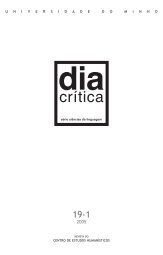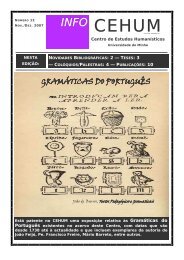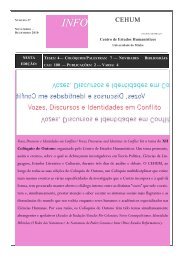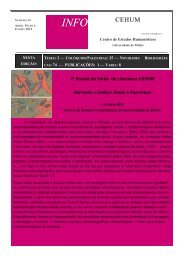Revista (PDF) - Universidade do Minho
Revista (PDF) - Universidade do Minho
Revista (PDF) - Universidade do Minho
You also want an ePaper? Increase the reach of your titles
YUMPU automatically turns print PDFs into web optimized ePapers that Google loves.
218<br />
DIACRÍTICA<br />
By 1998, the top one percent owned 39 percent of America’s disposable<br />
wealth, up from 33.8 percent in 1983. During the 1990’s, the share of<br />
total income earned by the top twenty percent has risen to its highest<br />
point since 1947.<br />
European wealth is not as concentrated as American, but there is<br />
little reason to believe that you will escape similar trends in the future.<br />
Only one thing is clear. Our politics has not caught up with this<br />
three-class reality. At the top of the social scale, we heap large subsidies<br />
on the symbol-using class, giving vast subsidies to university<br />
students. At the bottom, we target the underclass with substantial<br />
assistance. But we <strong>do</strong> relatively little to aid the vast middle. While the<br />
rich have been showered with tax breaks, the middle class has been<br />
treated to a series of symbolic gestures signifying little or nothing.<br />
The result is simmering resentment, which will take uglier forms<br />
as the current economic boom comes to an end. It is past time to<br />
search for a more constructive response to economic inequality. How<br />
can we use the benefits of globalization to ensure that every citizen gets<br />
a fair start in life?<br />
This is the question that Anne Alstott and I asked ourselves in our<br />
book on The Stakeholder Society. 1 Our basic proposal is straightforward,<br />
but it is only based on an intensive analysis of American<br />
economic data. The numbers I will be presenting can only be treated<br />
as suggestive in the European context. Nonetheless, they should give<br />
you a sense of the orders of magnitude involved.<br />
As young Americans rise to maturity, each should claim a stake of<br />
$80,000 as part of their birthright as citizens. This stake should be<br />
financed by an annual wealth tax, equal to two percent of every<br />
individual’s wealth in excess of $230,000. 2 The tie between wealthholding<br />
and stake-holding expresses a fundamental social responsibility.<br />
Every American has an obligation to contribute to a fair starting<br />
point for all.<br />
There are many possible variations on the stakeholding theme,<br />
and recently Tony Blair made one into a centerpiece of his successful<br />
——————————<br />
1 Yale University Press, 1999. All the data provided in this speech are supported<br />
more elaborately in the book.<br />
2 My original proposal provided an $80,000 exemption for each taxpayer, but this<br />
was on the basis of data for 1995 collected by the Federal Reserve Board at a time when<br />
the Dow was at 4500. While the Fed has yet to publish more recent data, we have<br />
recently undertaken a further analysis of higher exemption levels that suggests that,<br />
given the ongoing boom, a higher exemption is now compatible with our proposal. Our<br />
new cut-off of $230,000 would entirely exempt eighty percent of Americans from the tax.











![Programa [pdf] - cehum - Universidade do Minho](https://img.yumpu.com/17305425/1/190x135/programa-pdf-cehum-universidade-do-minho.jpg?quality=85)




